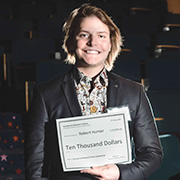Sunnybrook Research Institute presents biomedical engineering student with prestigious prize
By Eleni Kanavas
Robert Hunter is the winner of the 2016 Sunnybrook Research Prize thanks to his love for math and science, mixed with a passion for developing technologies that can have a positive impact on people’s lives.
Hunter, a fourth-year biomedical engineering student at the University of Guelph, won the prestigious award along with a $10,000 cash prize for his research on the use of biosensors for the diagnosis, management and tracking of diabetes. He was among 10 undergraduate students from universities across Canada invited to present their research projects at the fifth annual competition held Jan. 8, 2016 at Sunnybrook Research Institute (SRI).
“My initial reaction when my name was called as the winner was one of complete shock. There were a lot of great presentations, and I was honoured to be chosen,” said Hunter, who is from Georgetown, Ontario.
Supervised by Dr. Suresh Neethirajan, an engineering professor who leads the BioNano lab at the University of Guelph, Hunter spent eight months developing electrochemical biosensors for metabolic disease biomarkers and influenza virus strains.
“The aim of my project was to develop and validate a versatile “lab-on-a-chip” platform that could be used in a variety of medical applications. We wanted to develop a system which possessed a good detection performance while being significantly faster and easier to use than conventional analytical methods,” he said. “My research is important because the biosensing platform that was developed is very modular due to the versatility of graphene oxide [a carbon compound].”
The daylong event opened with remarks from Dr. Michael Julius, vice-president of research at SRI and Sunnybrook, who welcomed attendees. He congratulated the students on their hard work and spoke to them about pursuing a career in scientific research.
The finalists were the most geographically diverse group yet. They came from Alberta, British Columbia, New Brunswick, Nova Scotia and Ontario. Presentations included a range of topics from using body heat to power sustainable hearing aid devices to developing 3-D printed knee meniscus scaffolds for tissue engineering to help patients with knee injuries.
Dr. Meaghan O’Reilly, a scientist in Physical Sciences, chaired the competition and was among the panel of judges comprised of SRI scientists.
“All of the presentations were of exceptionally high quality this year. We have had some outstanding presentations over the years, but this group really set the bar high,” she said. “Choosing one winner was hard because all of the finalists were outstanding, and it is challenging to compare projects from such a broad range of disciplines. Although we consider many different factors, how the finalists respond to questions can have a big impact.”
Each finalist had 15 minutes to present his or her work and five minutes to answer questions from the judges and audience.
The national award was established by faculty in SRI’s Physical Sciences platform. The aim is to recognize excellence in undergraduate research and promote careers in biomedical research. The competition is open to undergraduates in their third or fourth year of study at a Canadian university. Award funding comes from income generated by royalties from technology developed by SRI scientists.
O’Reilly also noted the competition provides undergraduate students with the opportunity to showcase their work and see high-quality research being conducted by their peers from other institutions.
In the afternoon, O’Reilly led the students on a tour of the labs within SRI’s Centre for Research in Image-Guided Therapeutics. The state-of-the-art facility brings together scientists and clinicians to develop new and better ways to detect, diagnose and treat complex health conditions, including cancer and disorders of the heart and brain.
Later in the day, Dr. Charles Cunningham, a senior scientist in Physical Sciences, gave a presentation on the department of medical biophysics at the University of Toronto, with an aim of encouraging students to consider it for further study.
The event closed with Dr. Kullervo Hynynen, director of Physical Sciences, congratulating the finalists on their excellent projects and announcing the winner.
“This whole experience has fueled my drive to continue research even more,” Hunter said. “It is my dream to be able to bring new and powerful technologies into the medical field to improve human health worldwide.” He plans to pursue graduate studies in the biomedical engineering field, more specifically in either biophotonics or nuclear medicine, at a Canadian university.
The other finalists and their projects were as follows:
- Kelly Foran, fourth-year physics, Mount Allison University: “Exploring the use of X-ray fluorescence to determine concentrations of zinc in bone.”
- Vinyas Harish, third-year biomedical computing, Queen’s University: “Measuring electromagnetic tracking error in computer-navigated breast cancer surgery.”
- Tyler Herod, fourth-year mechanical engineering, Dalhousie University: “Strength versus endurance: Smarter allograft selection could lead to improved in vivo allograft performance.”
- Brian Mukeswe, third-year electrical engineering, University of British Columbia: “Utilizing body heat to sustainably power assistive hearing devices.”
- Bach Kim Nguyen, fourth-year chemistry, York University: “Plasmonic nanoparticle assemblies for the detection of microRNA biomarkers.”
- Farhang Tarlan, fourth-year engineering science, University of Toronto: “Bioactive composite fibers direct endothelial cell alignment.”
- James Tedesco, fourth-year materials science and engineering, McMaster University: “Microscopical evaluation of a novel titanium implant using a rabbit model.”
- Petr Smirnov, third-year mathematics and physics, University of Toronto: “Design of a HIFU (high-intensity focused ultrasound) array for the treatment of deep venous thrombosis: a simulation study.”
-
Alexander Szojka, fourth-year mechanical engineering, University of Calgary and University of Alberta: “3-D printed biomimetic meniscus scaffolds for tissue engineering.”





